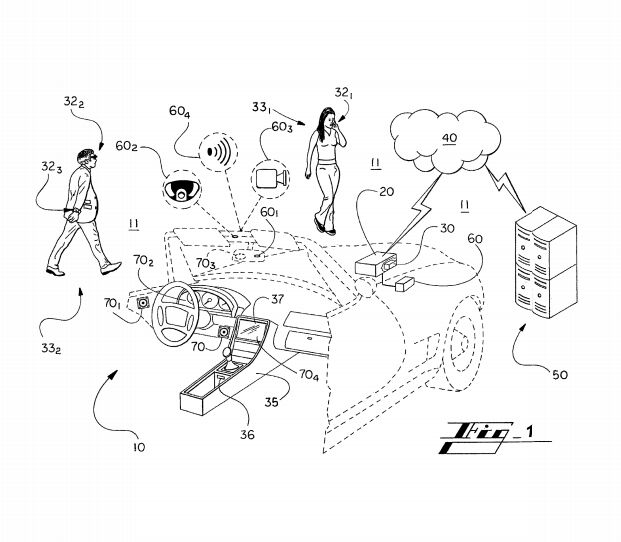Hide and Seek: GM Seeks Patent for Vehicle-to-Pedestrian Communication

Here at TTAC, we sometimes offer up a story published by a sister publication after deciding it’s something worthy of your time. This piece, published by GMInsideNews, fits that bill. While the soulless autonomous future scares many of us, General Motors is working on a way to stop those driverless cars from plowing over each and every one of us. Read on.
General Motors continues to pour money and time into perfecting vehicle autonomy.
One of the integral themes of an autonomous driving future is communication. Vehicles will be required to rapidly and constantly talk to one another, relaying position, speed, and intent, with the same demands applying to our roadways and intersections — which will be expected to relay weather, traffic, and safety information in real time as vehicles approach.
Pedestrians, however, pose a unique problem. In busy cities, pedestrians and drivers routinely communicate nonverbally by making eye contact or gesticulating, but an autonomous vehicle doesn’t have that privilege. Its machine code is dependant on a series of binary questions it must ask itself in order to determine if the person is a threat, which — if affirmative — currently results in the car coming to a halt, which on occasion has caused a rear-end collision, or two.
Well, GM is working on a system in which autonomous vehicles will be capable of better understanding the motions of pedestrians by communicating with their Internet-connected devices, be it smart-phones, wearables, or perhaps even future advancements made towards transhumanism.
According to a patent application published on January 30, 2018, by the U.S. Patent and Trademark Office, GM is working on a vehicle-to-pedestrian communication system that will be able to determine a pedestrian’s presence and proximity based on the interface between the car and the device.
According to the document, the system aims to establish digital contact between the vehicle and pedestrian, focusing in particular on blind situations, where neither party is “aware” of the other’s presence.
For example, a pedestrian moving quickly toward the road from behind a visual impediment like a bus-stop, building, or even other pedestrians, may not see or hear the approaching vehicle, especially if they’re focused on their phone or using headphones. However, there’s also a rarer, albeit far more dangerous situation this system is hoping to avoid: the unsighted pedestrian on a rural road or the hard to see person standing on the side of a freeway.
After quickly running the location data through a path-prediction algorithm, GM’s proposed interface will then either alter the autonomous vehicle’s behavior, warn the pedestrian of the vehicle’s impending arrival, or, in emergency circumstances (like an impending autonomous vehicle crash), the pedestrian(s) could be warned to GTFO.
In some cases, the algorithm may simply determine that neither party can “see” each other, and in turn alert both to each other’s presence, without the need to take further action. Or, it could ask the pedestrian to wait before entering the intersection because the road is icy and the AV approaching might not be able to stop.
While much of the patent’s examples describe autonomous vehicles, the technology is not limited to use when an AV is being operated autonomously, pointing to the potential for the technology to debut before we reach full-on private autonomy.
[Images: General Motors, U.S. Patent and Trademark Office]

More by Michael Accardi
Latest Car Reviews
Read moreLatest Product Reviews
Read moreRecent Comments
- SCE to AUX Sure, give them everything they want, and more. Let them decide how long they keep their jobs and their plant, until both go away.
- SCE to AUX Range only matters if you need more of it - just like towing capacity in trucks.I have a short-range EV and still manage to put 1000 miles/month on it, because the car is perfectly suited to my use case.There is no such thing as one-size-fits all with vehicles.
- Doug brockman There will be many many people living in apartments without dedicated charging facilities in future who will need personal vehicles to get to work and school and for whom mass transit will be an annoying inconvenience
- Jeff Self driving cars are not ready for prime time.
- Lichtronamo Watch as the non-us based automakers shift more production to Mexico in the future.



































Comments
Join the conversation
“In busy cities, pedestrians and drivers routinely communicate nonverbally by making eye contact or gesticulating, but an autonomous vehicle doesn’t have that privilege.” Or, trickier yet, communicating by not communicating. Any experienced city pedestrian knows that if you make eye contact with most drivers they take that as a license to blow past you when they are legally required to stop. The only way to get most drivers to stop for you is to pretend artfully that you have no idea they’re there. That’s a challenging behavior to teach a computer about.
My UFO enthusiast friends tell me that the technology to biologically and non verbally communicate electronically with humans already exists in the form of rectal probes. All GM needs to do is to hack into the code that activates the electric shock function of said probe if an autonomous vehicle detects a human about to step in front of it.